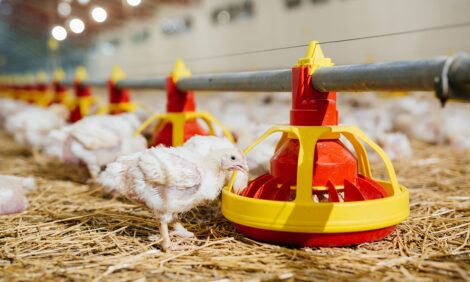



Incubation Temperature Profiles Affect Broiler Feathering
This North Carolina State University study - looking at the effects of incubation temperature, breeder feeding programme and litter management on feather follicle development of broilers - may help to improve broiler welfare and reduce the incidence of scratches and lesions on chicken carcasses.Two experiments have been conducted at North Carolina State University by Dr Edgar Oviedo and colleagues to assess the effects of incubation temperature profiles, breeder feed restriction programmes and litter conditions on progeny feather follicle density and skin layer thickness.
Their paper in Journal of Applied Poultry Research describes how, in the first experiment, Cobb 500 fast feathering breeders were subjected to two feed restriction programmes during rearing:
- skip-a-day (SAD) and
- every-day feeding (EDF).
Eggs from each group were incubated according to two incubation temperature profiles: standard (S) and early-low late-high (LH).
A total of 72 chicks per treatment combination were placed in Petersime cages (six birds per cage) and sampled for skin in the breast, dorsum and thigh areas at 22 days of age.
Additional samples were collected from the thigh and measured for epidermal and dermal thickness.
For the second experiment, 2,475 eggs from a commercial flock of Cobb 500 fast feathering breeders were subjected to three incubation temperature profiles: S, LH and standard-high (SH).
At hatch, 1,260 chickens were placed in floor pens (14 birds per pen) that contained either used litter or new wood shavings.
At 28 days of age, two chickens per pen were sampled for skin in the breast, dorsum and thigh areas.
In both experiments, feather follicles were counted in 4.5 square centimetres.
Oviedo and colleagues concluded that incubation temperature affected feathering development in both experiments, especially in the breast.
This effect appeared to be stronger in progeny from breeders restricted under SAD feed restriction programmes.
They also found that litter conditions impacted feather follicle numbers.
These findings may be applied to minimise carcass scratches and improve broiler welfare, concluded the researchers at Prestage Department of Poultry Science.
Reference
Scott J., M.J. Da Costa and E.O. Oviedo-Rondón. 2015. Incubation temperature profiles affect broiler feathering. J. Appl. Poult. Res. 24: 49-57.
May 2015








